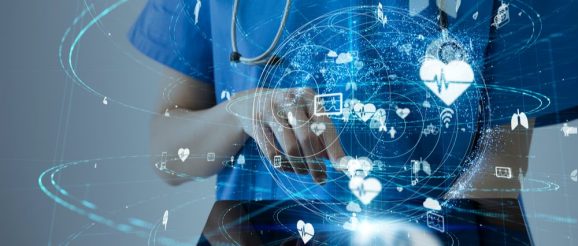How IoMT opens a new interconnected frontier – Med-Tech Innovation

Head of Innovation at Scottish Health Innovations Ltd (SHIL), Robert Rea discusses how the Internet of Medical Things opens exciting opportunities for healthcare innovators.
The Internet of Medical Things (IoMT) may sound like a science fiction term describing some yet unimagined future, but it is in fact very much a reality in the here and now thanks to the huge power of wireless 5G connectivity — one that offers limitless potential.
Today, IoMT tools are rapidly changing healthcare delivery thanks to their vast, and in many ways untapped, ability to collect and analyse health data in real time.
Transmission, or sharing, of that data through a cloud repository is the next crucial link in the IoMT chain.
Effectively, information is passed to and from other devices in an interconnected ecosystem and interpreted by a network of medical devices, software applications, and health systems and services to drive better, more efficient usage of resources. Essentially, this often very dense infrastructure aims to realise better outcomes in healthcare through more accurate diagnoses and lower care costs produced by streamlined clinical workflow management.
In turn, for patients that can mean greater accessibility of healthcare, better patient health, and heightened satisfaction with healthcare services.
In practical terms, the IoMT can mean everything from sensors in pharmaceutical shipments that measure temperature, humidity, and tilt to ensure they arrive in the best possible condition, or simply smart monitoring of room usage throughout a care facility ensuring that electricity and heating are being deployed only when needed, with significant sustainable permutations.
Furthermore, for both patients and clinicians, IoMT applications are playing a central role in tracking and preventing chronic illnesses thanks to the highly accessible use of smartphone technology, such as in the case of providing personalised medicine for specific cancer patients.
Impressively, the IoMT has also facilitated the introduction of ‘smart pills’ that contain microscopic sensors, which, once swallowed, can transmit data to connected devices. This can mean better adherence to patients taking medication, a particular concern for patients with dementia and mental illness.
Another beneficial example is an implanted artery device which can alert healthcare professionals to the early signs of a stroke.
For patients particularly, the IoMT can allow for more independent management of healthcare requirements, not to mention the ability to quickly access help in emergency situations.
Wearable devices like smart watches are allowing healthcare professionals to remotely monitor their patients’ wellbeing – through the analysis of blood pressure, heart rate, sleep patterns and step count – thus allowing observation and treatment that was previously only possible in an institutional setting and improving quality of life. This is proving to be transformative for housebound patients living a significant distance away from healthcare facilities.
Arguably the IoMT could not have come at a better time. With integrated artificial intelligence, the IoMT will only have ever greater applications as we look to gradually emerge from the pandemic and continue to provide care remotely while freeing up vital bed space for patients who need more intensive care.
It all adds up to a vast opportunity for large-scale healthcare improvements amid an ever-growing multi-billion-dollar global market. Scotland is in a powerful position to capitalise on this technological revolution thanks to its strong infrastructure.
CENSIS – the Scottish Innovation Centre, for sensing, imaging, and Internet of Things technologies – is supporting a series of testbed projects across hospitals and healthcare facilities in the Highlands and Islands. It is part of a bid to explore how NHS Highland can drive efficiency and enhance user and staff experience, in turn improving sustainability and saving public money. This includes monitoring room usage, analysing and predicting earlier when equipment will need repair, and tracking expensive, portable assets such as wheelchairs. Such non-clinical uses of IoT are a significant growth area for CENSIS.
Another big driver for IoMT is the growth in new communications networks such as Low Power Wide Area Networks (LPWAN). These are relatively inexpensive use and operate across long distances from the base stations. They can run on small, inexpensive batteries for many years, and are designed to transfer very small packets of data making them ideal for monitoring things like heart rate, body temperature or oxygen saturation. This has the potential to deliver personalised care in a home setting.
Another major growth area for CENSIS across the next decade is a project with Blackwood Housing, an organisation providing high-quality, innovative care for the elderly and people living with physical disabilities and long-term conditions. Working together they are integrating technology in the community with the aim of extending healthy years of life.
According to CENSIS’s director of strategic projects Stephen Milne, a key focus is engendering privacy and trust while also asking, “How do you develop your devices? How do you build on what has already been achieved, what we know works – and then improve and extend it?”
Nevertheless, while this new technology is continuously pushing the boundaries of healthcare, and that is of course to be encouraged, the drive for innovation must also be tempered by the need to meet regulatory, intellectual property, and implementation challenges.
Fortunately, SHIL continues to be a trusted partner for the NHS in supporting innovators and satisfying compliance demands. SHIL has a strong track record of identifying, protecting, developing, and commercialising healthcare innovations that improve patient care; and whilst this rich health tech landscape comes with necessary regulatory challenges, they are by no means insurmountable.
With the increasing growth and potentiality of the IoMT, the health industry, and new medical device innovators, will increasingly need to overcome those demands, while still realising the substantial benefits of ground-breaking ideas. Organisations like CENSIS and SHIL provide the technological and regulatory expertise to complement clinical skills, knowledge, and experience – essential components when implementing new technology into the NHS.
